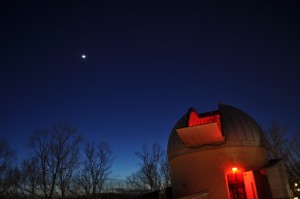
Talk at 7:30PM. Observing session from 8:00PM to 10:00PM. Please verify the event is still on at the website below before going!
Campus Map – The George Mason University Observatory at the Fairfax Campus building Research Hall formerly known as Research I.
Fantastic visibility for all of North America and much of South America. Maximum eclipse is at 7:46am UTC (2:46am central US time.)
Don’t miss this one!
http://en.wikipedia.org/wiki/April_2014_lunar_eclipse
April’s Full Moon is the “Egg Moon”, “Pink Moon”, “Sprouting Grass Moon”, “Fish Moon”, “Seed Moon”, “Waking Moon”, or “Hanuman Jayanti”.
The Lyrid meteor shower will reach its maximum rate of activity. Some meteors will be visible each night from 16 Apr to 25 Apr, but the best show will be on this evening. The maximum number of meteors expected to be visible from a dark location is around 10 per hour (ZHR). The 2nd quarter moon will wash out some meteors, but the brightest ones will shine through.

Talk at 8:00PM. Observing session from 8:30PM to 10:30PM. Please verify the event is still on at the website below before going!
Campus Map – The George Mason University Observatory at the Fairfax Campus building Research Hall formerly known as Research I.
AKA “Ring of Fire” eclipse. Maximum eclipse at 6:04 am UTC. Decent visibility for Australians and GREAT visibility for Antarcticans. Er, south-polers? Penguins.
This shower is composed of dusty remnants of the famed Halley’s Comet. The long-running shower is visible from April 19th until May 28, but peaks overnight on May 5th with up to 60 sightings per hour. The first quarter moon should set right around midnight local time, which will really improve conditions for spotting meteors. Though the meteors can appear anywhere in the sky, it will appear that they are coming from the Aquarius constellation.

Talk at 8:00PM. Observing session from 8:30PM to 10:30PM. Please verify the event is still on at the website below before going!
Campus Map – The George Mason University Observatory at the Fairfax Campus building Research Hall formerly known as Research I.

